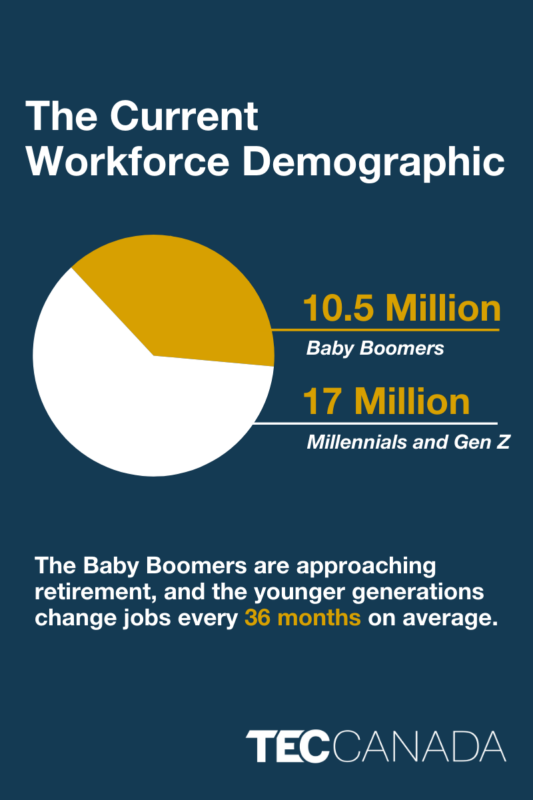Insight into the Labour Shortage for Employees and Employers
Reading time: 3 mins
The labour market is undergoing significant transformations, influenced by generational shifts, changing job requirements, and evolving hiring practices. As employers and employees navigate this dynamic landscape, understanding these changes is crucial for both retention and career success, and solving the observed labour shortage.
New Generations and Changing Work Preferences
Chris Quinn, President/CEO of Imprint Talent Readiness states that Canada’s workforce is changing, suggesting a labour shortage. In TEC Canada’s Deeper Insights Webinar, he observes the current workforce demographic. It now has 10.5 million Baby Boomers and a combined total of 17 million from Gen Z and Millennials. The Baby Boomers are approaching retirement, and the younger generations change jobs every 36 months on average.
This turnover is shifting workplace values from security to flexibility, making retention strategies and job satisfaction primary concerns. Employers now need to focus on understanding what drives different generations. Millennials and Gen Z seek diverse roles and experiences over long-term stability.
According to Rob Boersma, Chief of Staff at Talent.com, a leading job platform, the nature of recruiting and job searching is changing: “From our vantage point as a marketplace, we see both sides of the coin—how employers are trying to attract talent and how jobseekers are shifting their preferences. Companies looking to attract workers will need to figure out how to build new jobseeker expectations into their legacy structures. That can look like fractional roles, more/deeper contractor relationships, flexible working hours, or integration of freelancers.”
Discovering what motivates individuals differs widely. Many leaders assume what motivates them will motivate others. To retain talent, many employers are now leaning on behavioral and cognitive tests when assessing candidates and employees.

The Rise of Skills-Based Hiring

Hiring for experience and formal education is now changing to a skills-hiring-focused approach. Data from the Association of American Colleges and Universities (AACU) observed that less than half of employers surveyed think recent graduates are prepared for the workplace. Employers also state that the two most important skills they look for are the ability to work in teams and critical thinking.
Some companies now value learning agility (also known as general cognitive ability) over past job roles and experience hiring. Learning agility is essentially the rate at which someone can learn a new skill or acquire knowledge. A fast-changing economic environment requires employees who can quickly adapt and innovate. Companies often opt to hire someone without experience so they can be trained from scratch.
The shift towards skills-based hiring helps reduce mis-hires and streamlines the hiring process. This could include having a test as part of the application process, which can turn less serious candidates away. However, there is not enough evidence yet to see the long-term impacts of this process.
Boersma says up-skilling within companies is also on the rise: “Companies need to be able to reskill their workers, rather than oil-changing staff as needs change. As the BoC looks to start easing interest-rate pressures, companies will start opening jobs faster again, and competition for workers will heat up. Companies who offer upskilling/reskilling will stand out above the others and be able to have deeper pools of candidates.”
Canada’s Labour Shortage and Economic Pressures
The economic climate is also influencing hiring practices. In 2022, there was one job opening for every applicant on LinkedIn. By 2023, the ratio had shifted to one job for every two applicants.
High interest rates have led companies to conserve capital and minimize hiring risks. They may have reduced hiring altogether or are opting for candidates with more experience than required. This is enabled by the increase of competition in the job market.
This cautious approach has led to inflated job requirements and a perceived skills gap, as noted by Peter Cappelli, Professor of Management at the Wharton School. It is further exacerbated by the trend of recent job cuts, with recruiter jobs being a target of many of these layoffs. Without experienced recruiters, companies struggle to match job requirements with the available talent pool.
The Changing Role of Education and Experience
The shift in hiring practices also reflects a broader questioning of the role of formal education. While more companies are willing to hire without traditional degrees, there remains a disconnect between the fields students are studying and the job market’s needs. This mismatch is particularly stark in trades and technical fields, where demand remains high but fewer students are pursuing related studies. Moreover, entry-level positions are declining, putting recent graduates at a disadvantage unless they can demonstrate relevant skills and adaptability.
This could be why some employment trends suggest a labour shortage. While there may not be a significant job shortage at this time, we could be seeing a skills shortage or an education gap.
Conclusion
Standing out in the job market means not only offering competitive salaries but also opportunities for growth and flexibility. Chris Quinn suggests viewing your job postings like a marketing campaign. Be creative and challenge the status quo to attract the right talent. Peer groups, thought leadership, networks, and personal mentors, such as those found at TEC Canada, can be a great resource for any business leader when implementing new strategies.
For employees, it’s becoming increasingly important to acquire skills and to remain adaptable in an ever-changing job landscape. Both sides must strive toward a more nuanced understanding of job requirements and candidate capabilities. Both employees and employers need to be agile and flexible to bridge the gap in the evolving needs of the labour market.
Navigating the rapidly changing labour market can be challenging for both employers and employees. From understanding generational shifts and evolving job requirements to embracing skills-based hiring and adapting to economic pressures, staying ahead in this dynamic environment requires insight and flexibility. At TEC Canada, we provide the guidance and resources needed to tackle these talent obstacles.


